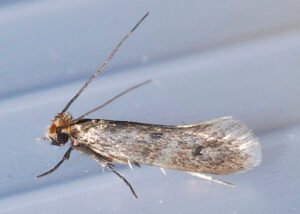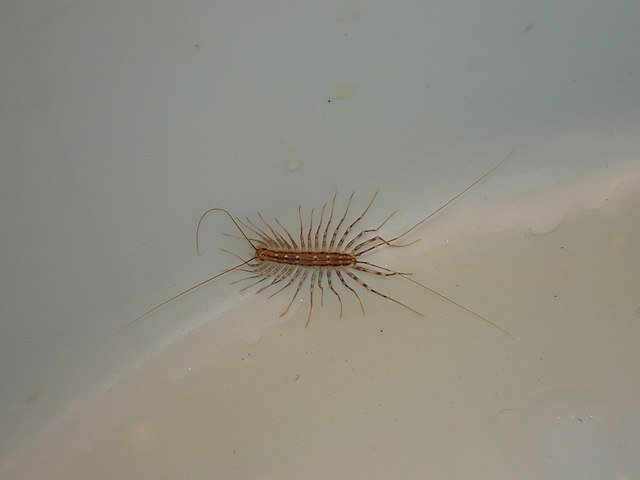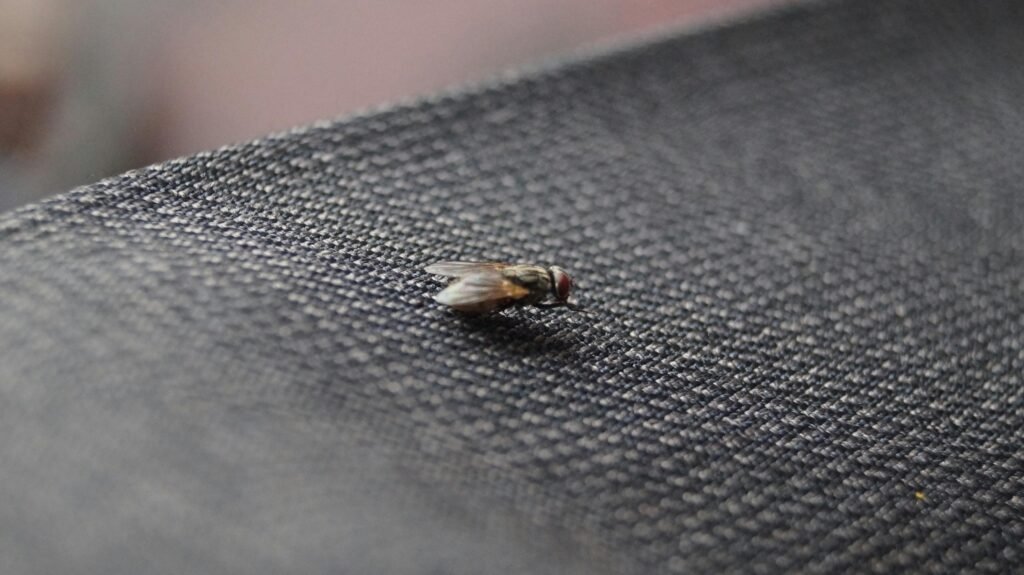Webbing Clothes Moth (Tineola bisselliella): Identification, Damage & Control
 The Webbing Clothes Moth (Tineola bisselliella) is the single most notorious textile pest in households and museums worldwide. Unlike pantry insects such as the Cigarette Beetle (Lasioderma serricorne) or stored product pests like the Rice Weevil (Sitophilus oryzae), webbing clothes moths target fibers derived from animals—wool, silk, fur, feathers, and leather.
The Webbing Clothes Moth (Tineola bisselliella) is the single most notorious textile pest in households and museums worldwide. Unlike pantry insects such as the Cigarette Beetle (Lasioderma serricorne) or stored product pests like the Rice Weevil (Sitophilus oryzae), webbing clothes moths target fibers derived from animals—wool, silk, fur, feathers, and leather.
These small, golden-colored moths rarely fly out in the open. Instead, they lurk in dark, undisturbed areas of closets, wardrobes, attics, or storage boxes. The adults themselves do not eat; it is the larvae that quietly chew holes into cherished garments, upholstery, and even priceless museum artifacts. By the time their damage is noticed, an infestation may already be well underway.
This guide will break down their biology, identification, behavior, and the control strategies both homeowners and professionals use to protect clothing, furniture, and collections.
Identification
Adult size: 6–8 mm body length, wingspan around 12–16 mm.
Coloration: Uniform golden or buff with a reddish-golden sheen; wings are narrow and fringed with long hairs.
Behavior: Weak fliers, adults prefer to crawl and avoid light.
Larvae: Cream-colored caterpillars with brown heads. They spin silken tubes or sheets (webbing) on the infested fabric.
Key difference: Unlike the Case-Bearing Clothes Moth (Tinea pellionella), webbing clothes moth larvae do not construct portable cases. Instead, they remain within silken webbing patches.
Field tip: Finding irregular silk sheets or mats directly on fabric is a strong indicator of webbing clothes moth larvae.
Biology and Lifecycle
Eggs: Females lay 40–50 eggs directly on suitable fabric or hair/fur.
Larvae: Feeding stage lasts from 1 month up to 2 years, depending on conditions and food availability.
Pupae: Larvae pupate in silken cocoons often camouflaged with fibers.
Adults: Live only 2–4 weeks, long enough to mate and lay eggs.
Lifespan: Whole cycle may be completed in 2–6 months in favorable warm and humid conditions.
This long and flexible lifecycle makes infestations especially difficult to eradicate, as overlapping generations may be present in the same closet.
Ecology and Distribution
Found worldwide, with high activity in temperate and subtropical regions.
Strongly associated with human dwellings, particularly where woolens and stored fabrics are abundant.
Common in Europe, North America, Asia, and increasingly in museum collections globally.
Thrive in dark, undisturbed areas where fabrics remain untouched for months.
Damage and Risks
Clothing & Textiles: Holes in wool sweaters, coats, scarves, and suits.
Fur & Leather: Larvae feed on keratin in animal hair and skin.
Museum Collections: Damage to historical garments, tapestries, mounted specimens, and natural history displays.
Furniture: Upholstered chairs and cushions are vulnerable.
Economic impact: Billions in textile damage annually worldwide.
Unlike nuisance pests such as Fungus Gnats or Fruit Flies, webbing clothes moths cause long-term material loss that cannot be undone.
Signs of Infestation
Irregular holes in wool or silk garments.
Silken mats or webbing directly on fabrics.
Tiny cream larvae hiding in folds and seams.
Adult moths crawling on walls near closets or storage rooms.
Presence of cocoons in corners or folds of fabric.
Household Control Strategies
1. Prevention
Store woolens in airtight containers or garment bags.
Use cedarwood or lavender sachets to repel adults (though not always effective against larvae).
Regularly air out and shake garments.
2. Cleaning
Frequent vacuuming of carpets, baseboards, and closets.
Dry cleaning or laundering woolens before long storage, as larvae prefer soiled fabrics.
3. Environmental Management
Lower humidity in storage areas.
Use sunlight exposure: larvae dislike bright light and disturbance.
4. DIY Treatments
Freezing infested items (−18 °C for several days) kills larvae and eggs.
Heat treatments (above 50 °C for at least 30 minutes) are equally effective.
Professional and Long-Term Control
1. Monitoring
Pheromone traps capture adult males, useful for detecting hidden infestations.
2. Integrated Pest Management (IPM)
Professionals combine cleaning, monitoring, and targeted treatments.
In museums, strict environmental controls (temperature and humidity) are used.
3. Insecticides
Generally avoided in homes due to risk of fabric staining and human exposure.
Spot treatments may be used by certified professionals when infestations are severe.
4. Biological Control
Research is ongoing into natural enemies such as parasitoid wasps that can target moth larvae in collections.
Comparisons with Similar Pests
Case-Bearing Clothes Moth (Tinea pellionella): Builds portable cases; webbing clothes moth larvae stay in fabric mats.
Carpet Beetles (Anthrenus spp.): Feed on similar materials but are beetles, not moths; larvae are hairy and shed skins are a common sign.
Booklice and Silverfish: May damage books and paper products but rarely textiles.
Cigarette Beetles and Drugstore Beetles: Pantry pests with no impact on fabrics.
Final Thoughts
The Webbing Clothes Moth (Tineola bisselliella) is not just a nuisance—it is a silent destroyer of textiles. Its larvae can cause irreversible damage to clothing, upholstery, and heritage collections. Unlike pests such as Fruit Flies or Mosquitoes, which are more about annoyance, clothes moths create lasting financial and cultural losses.
The real challenge lies in their stealth. Adults hide in darkness, larvae weave protective silk mats, and infestations often go unnoticed until visible holes appear. This makes prevention, monitoring, and early detection the most important strategies for homeowners and institutions.
For individuals, simple steps such as cleaning, proper storage, and occasional inspection of garments can save hundreds of dollars. For museums and archives, rigorous Integrated Pest Management (IPM) ensures the survival of irreplaceable textiles.
Ultimately, these tiny golden moths remind us that even the smallest creatures can have a massive impact—economically and historically.
FAQs About Webbing Clothes Moths
Q: Do adult webbing clothes moths eat clothes?
A: No. Adults live only to mate and reproduce. It is the larvae that damage textiles.
Q: How are they different from case-bearing clothes moths?
A: Webbing clothes moth larvae spin silk mats directly on fabrics. Case-bearing larvae create portable silk cases they carry with them.
Q: Can webbing clothes moths infest synthetic fabrics?
A: They prefer animal fibers like wool, silk, fur, and feathers. Synthetic fabrics are generally safe, unless blended with animal fibers.
Q: What’s the best natural method to kill them?
A: Freezing or heating infested items is highly effective, alongside regular cleaning and vacuuming.
Q: How long can an infestation last?
A: Depending on conditions, larvae may survive up to 2 years, making infestations persistent if not properly addressed.
Disclaimer
This article is for informational purposes only. Pest control laws and approved chemicals vary by country. For best results and legal safety, we strongly recommend contacting a licensed pest control professional in your local area. Always make sure that the pest control technician is properly certified or licensed, depending on your country’s regulations. It’s important to confirm that they only use approved products and apply them exactly as instructed on the product label. In most places in Europe, UK, or USA, following label directions is not just best practice—it’s the law.
Author
Nasos Iliopoulos
MSc Agronomist & Certified Pest Control Expert
Scientific Director, Advance Services (Athens, Greece)
Licensed Pest Control Business – Ministry of Rural Development & Food (GR)
References
Penn State Extension – Clothes Moths
Wikipedia – Webbing Clothes Moths (Tineola bisselliella)


